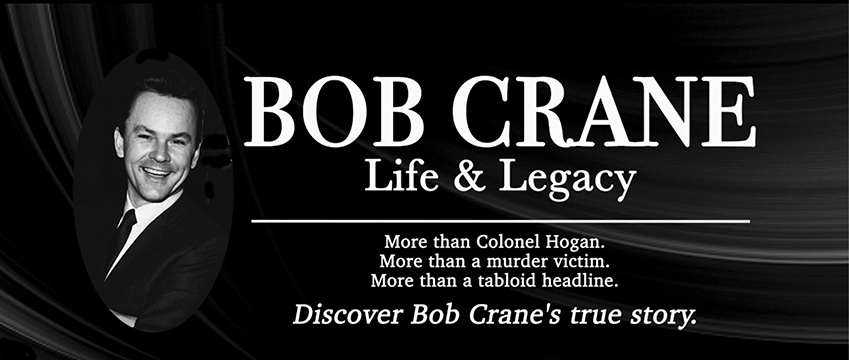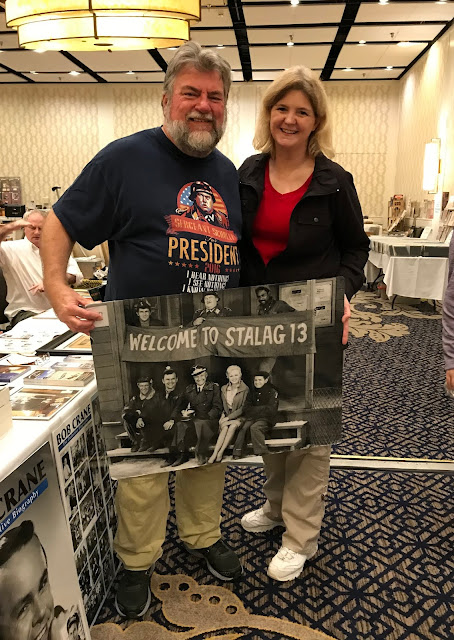
For Hogan's Heroes fans, a never-miss in the holiday line up is The Hollywood Palace Christmas Special, which aired on ABC on December 25, 1965. Bob Crane and the cast of Hogan's Heroes are prominently featured in the variety holiday show, hosted by Bing Crosby. Below is the preserved film, along with the program listing, which—fortunately for us—are made available by The Hollywood Palace.
The Hollywood Palace Christmas Special (December 25, 1965)
- Bing Crosby: "White World of Winter"
- Bob Crane, Bing Crosby and Dorothy Collins: "We Wish You the Merriest"
- Bing Crosby and Dorothy Collins: "Glow Worm"
- Fred Waring and his Pennsylvanians: "Twelve Days of Christmas"
- Robert Clary: "French Christmas Song"
- Werner Klemperer and John Banner: "Stille Nacht" ("Silent Night" in German)
- Andre Tahon (puppeteer)
- Bob Williams and Louie the Dog (humorous animal act): Overly enthusiastic man tries to get his lazy dog to do tricks.
- The cast of Hogan's Heroes (Bob Crane, Werner Klemperer, Richard Dawson, John Banner, Robert Clary, Larry Hovis, and Ivan Dixon) joins Bing in a sketch.
Of course, Bing Crosby, who was a regular host of The Hollywood Palace, also produced and owned Hogan's Heroes. John Banner referred to him as "der Bingle" in this Christmas Special. Banner's affectionate nickname for Crosby is used to this day, and perhaps by some who are unaware of its origins.
While it's fairly well known that the main cast of Hogan's Heroes could sing and often performed professionally, what is less known is that Bob Crane also enjoyed singing. We don't get to hear much of his singing except when he is on variety shows such as this one. He also liked to whistle, and once on his KNX radio show, he commented that he didn't know why he whistled all the time, but that he enjoyed it. His classmates from Stamford, Connecticut, also recalled how Bob loved to sing (in addition to all of his drumming!), and they said he was always singing and/or whistling while walking to and from school.
I found it interesting that The Hollywood Palace aired over ABC, while Hogan's Heroes made its home on CBS. It seems a bit unusual to feature an entire cast of a series—and in full costume—from a competing network. So I spoke with television historian Mitchell Hadley, author of The Electronic Mirror: What Classic TV Tells Us About Who We Were and Who We Are (and Everything In-Between!) and owner of the It's About TV website.
According to Mitchell, "There isn't anything to suggest there was any kind of an issue between the two networks [ABC and CBS]. 'TV Teletype' (a feature in TV Guide) referred to Vince Edwards appearing on Andy Williams' show on NBC while Ben Casey was still on ABC, which suggests these kinds of cross-appearances weren't that much of a big deal then. Also, considering Bing Crosby Productions had shows on multiple networks, Crosby probably would have had the clout to make this kind of thing happen. And CBS had recently cancelled Slattery's People, which Bing Crosby Productions produced, so even if they'd even thought of objecting, they might not have wanted to make 'der Bingle' mad—Again, assuming that it was even an issue back then."
As a fun side note, I love that Fred Waring and his Pennsylvanians are also a part of this episode. I had the opportunity to meet Mrs. Waring, if ever so briefly. My ex-husband and I lived in the Poconos near Delaware Water Gap in Pennsylvania, which was home to Fred Waring and his Pennsylvanians. One evening back in the mid-1990s, my then-husband Gary and I attended a concert, where Fred Waring and his Pennsylvanians performed. Just as we walked toward the theatre entrance, who should approach but Mrs. Waring! Gary had the honor of holding the door for her, allowing her to enter before us. I guess not much of a story—ha! But he always got a kick out of saying, "I held the door for Mrs. Waring."
I'll leave you with a few more fantastic stills from The Hollywood Palace's Christmas Special from 1965. All of us here wish you peace, love, health, and happiness this holiday season, and all the best for the new year!
I found it interesting that The Hollywood Palace aired over ABC, while Hogan's Heroes made its home on CBS. It seems a bit unusual to feature an entire cast of a series—and in full costume—from a competing network. So I spoke with television historian Mitchell Hadley, author of The Electronic Mirror: What Classic TV Tells Us About Who We Were and Who We Are (and Everything In-Between!) and owner of the It's About TV website.
According to Mitchell, "There isn't anything to suggest there was any kind of an issue between the two networks [ABC and CBS]. 'TV Teletype' (a feature in TV Guide) referred to Vince Edwards appearing on Andy Williams' show on NBC while Ben Casey was still on ABC, which suggests these kinds of cross-appearances weren't that much of a big deal then. Also, considering Bing Crosby Productions had shows on multiple networks, Crosby probably would have had the clout to make this kind of thing happen. And CBS had recently cancelled Slattery's People, which Bing Crosby Productions produced, so even if they'd even thought of objecting, they might not have wanted to make 'der Bingle' mad—Again, assuming that it was even an issue back then."
As a fun side note, I love that Fred Waring and his Pennsylvanians are also a part of this episode. I had the opportunity to meet Mrs. Waring, if ever so briefly. My ex-husband and I lived in the Poconos near Delaware Water Gap in Pennsylvania, which was home to Fred Waring and his Pennsylvanians. One evening back in the mid-1990s, my then-husband Gary and I attended a concert, where Fred Waring and his Pennsylvanians performed. Just as we walked toward the theatre entrance, who should approach but Mrs. Waring! Gary had the honor of holding the door for her, allowing her to enter before us. I guess not much of a story—ha! But he always got a kick out of saying, "I held the door for Mrs. Waring."
I'll leave you with a few more fantastic stills from The Hollywood Palace's Christmas Special from 1965. All of us here wish you peace, love, health, and happiness this holiday season, and all the best for the new year!
Happy Holidays!





















































